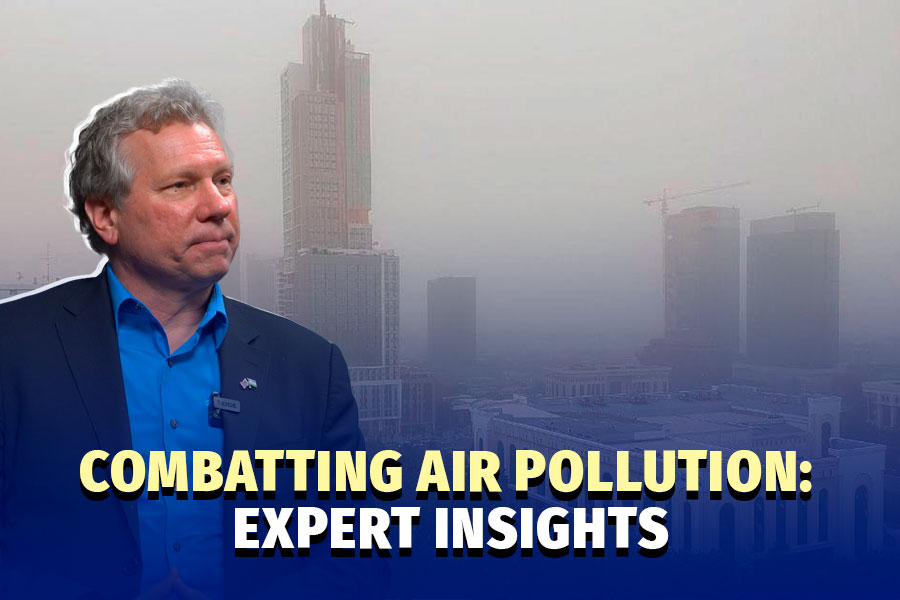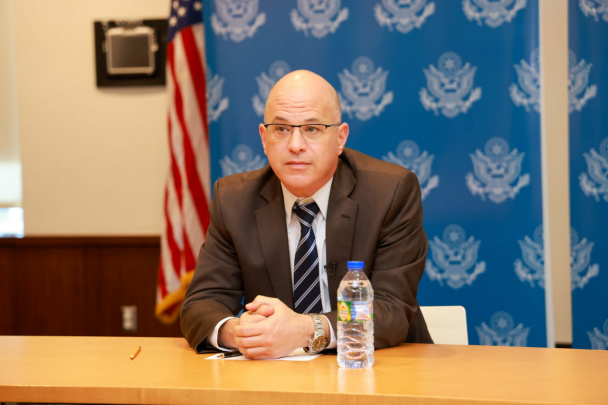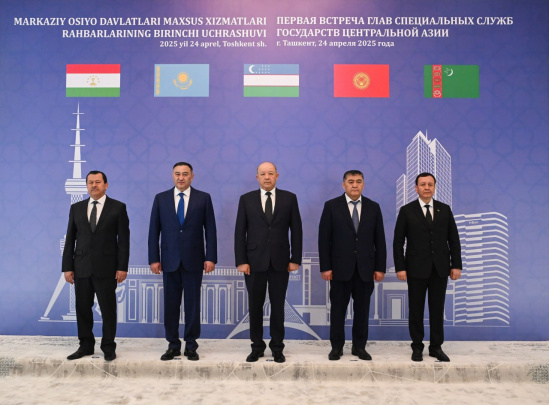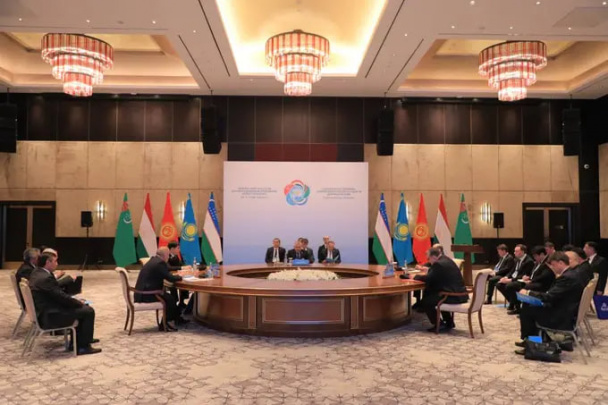American scientist comments on air pollution in Uzbekistan, shares his recommendations to improve air quality (exclusive interview)
Jay Turner, a professor at the University of Washington, USA, mentioned that although the level of air pollution may be decreasing globally, significant challenges persist in rapidly growing and highly urbanized regions, especially in Central Asia and Africa. Consequently, these areas see an increasing number of climate migrants. “To really do good air quality management, we first have to do the science," he said in an interview with Kun.uz.

Professor Turner, trained as a chemical engineer, specializes in environmental science and engineering. Before joining Washington University in St. Louis in 1994, Professor Turner served as an Air Quality Specialist at the Federal Highway Administration, part of the U.S. Department of Transportation.
Turner’s research primarily centers on air quality characterization and management, with a particular focus on field measurements and data analysis. These efforts support various applications, including atmospheric science, regulation, and policy, as well as health studies. Currently, his work receives funding from the National Institutes of Health and UNICEF.
During the American researcher’s visit to Tashkent, Kun.uz seized the opportunity to ask the professor questions on the subject.
– Good evening, professor. It's intriguing that when air quality discussions arise, terms such as PM2.5, PM1, or PM10 are commonly mentioned, which refer to particulate matter. Could you begin by explaining what 'PM' stands for and what the associated numbers indicate?
– I’d be happy to. Particulate matter, or PM, refers to particles that are suspended in the air. These particles are too small to see individually, but in large groups, they impair our ability to see over long distances. They can be composed of solid material or liquid droplets.
The numbers — PM1, PM2.5, and PM10 — indicate the sizes of the particles. For example, PM10 includes all particles smaller than 10 micrometers. To give a perspective, a typical human hair is about 60 micrometers in diameter. Thus, you could align six PM10 particles side by side to span across the width of a human hair. PM2.5 particles are even smaller, less than 2.5 micrometers. If we place these particles along the width of a hair, we could fit approximately 24 of them. These tiny particles require sophisticated scanning electron microscopes to be seen.
Their small size also means they can penetrate deep into our lungs and even enter our bloodstream. The Air Quality Index, or AQI, allows us to measure various pollutants simultaneously and report one composite value to the public. Each pollutant is scaled to its concentration, with the highest value typically used for public reporting, which simplifies the dissemination of air quality information. However, in many cases, reporting the concentration itself can be even more informative. Thus, both methods are utilized.
– We're aware of your extensive research on the sources of air pollution and its effects on people. Could you first share your findings on the primary causes of air pollution globally? And specifically, what issues do you see concerning air pollution in Central Asian countries?
– Globally, combustion is the largest source of particulate air pollution and this can be combustion from many different sources. This could be emissions from cars, from power plants in many parts of the world. They might be from cookstoves like in India. Heating stoves are another source if people are actually using a stove where they feel it themselves. This combustion or burning of solid fuels is the largest source of particle air pollution globally.
Now in Central Asia, it really varies across the different countries. Some of our best knowledge now is about Kyrgyzstan, and in Bishkek, the single largest contributor to wintertime air pollution is indeed people burning coal in stoves in their homes for wintertime heating. We don't know yet the dominant causes in Tashkent and Uzbekistan in general. This is the next step of what needs to be done to address air pollution.
– As you're aware, the Ministry of Ecology of Uzbekistan has indicated that air pollution in our country is most notable during the winter and autumn seasons. You mentioned earlier, and this seems to correlate with the burning of coal and fuel oil. Given this context, do you believe that the filters at coal-fired power stations are effective?
– Unfortunately, I do not have specific knowledge of the power plant designs in Uzbekistan, including the main power plant in Tashkent. Generally, these power stations utilize filters known as baghouses, which, when properly designed, installed, and maintained, can be extraordinarily effective at particle removal. They have the potential for very high efficiency.
Power plants are interesting because, as you noted, air pollution is at its worst in the winter months. These plants usually have very tall smokestacks, and the emissions are released from the top. In many cities, such as Bishkek, the power plant might be the single largest source of emissions. However, it may not have the most significant impact on ground-level air pollution during wintertime because the stack height allows emissions to be carried farther away instead of settling locally.
– To what percentage can even the most efficient filters reduce these emissions? Could you also comment on the financial implications for countries — what would be the average cost of installing one filter?
– The efficiency of these systems can vary significantly based on several factors, including the sizes of particulate matter they are designed to capture. Understandably, they can remove over 90% of particles, and other types of emissions control, like electrostatic precipitators, can achieve even higher efficiencies, sometimes above 97%. The actual efficiency depends on the particle sizes and the system's effectiveness in removing them.
The economic aspect is highly complex because it depends on the specific design, size, and capacity of the power plant. I can't provide a clear answer to that. I do know that the government of Kyrgyzstan recently received a $50 million zero-interest loan from the World Bank for air pollution control, and one of their initiatives is to upgrade controls at their central power plant.
– Have you observed the situation in Uzbekistan in terms of this issue? Can you share some observations?
– Yes, so far, we haven't conducted any detailed studies, especially not during the winter. As you mentioned earlier, pollution exhibits a very seasonal pattern, and indeed the dominant sources might change with the seasons. If heating is a significant source, it will primarily affect the winter months. Similarly, dust contributions are highly seasonal. In the summer and fall, we know that dust contributes, on average, about 30% to PM2.5 levels. The remaining 70% is not yet clear, and in winter, we simply don't have the data. Identifying these contributions is where our next efforts need to focus to develop effective control plans.
– When Tashkent's air quality significantly deteriorated, the Minister of Ecology attributed car emissions as the main cause. What percentage of PM2.5 do you think is contributed by vehicles? Are automobiles consistently identified as the primary pollutant on a global scale?
– Here in Tashkent, I really don't know the percentage contribution from vehicles, and I can't even make an educated guess at this point. I often refer to Bishkek because we've conducted work there. Although vehicle emissions were initially thought to be the dominant source in winter there, later findings proved this assumption incorrect. It's even more complex in Tashkent because many of your cars and trucks run on natural gas, which is cleaner in terms of particulate emissions. Gasoline and diesel vehicles are still present, but I'm not familiar with the controls they have or the types of fuel they’re using, which significantly impacts emissions.
Globally, vehicles are one of the most important sources, depending on the city, but this varies widely. For example, in Kathmandu, a highly polluted city in Nepal, smaller two-stroke engine motorcycles are more problematic than cars and trucks. Vehicles are indeed a major contributor worldwide, but Tashkent's situation is unique and warrants further investigation.
Tashkent is distinctive in terms of comparison with other cities. For instance, I often compare Ulaanbaatar and Bishkek due to their similarities in pollution sources and effects, as well as Almaty. However, Tashkent is different; your landscape, your fuels here, and the extensive use of gas make it unique. Good air quality management truly begins with sound science.
– On what standards and measurements is air quality determined? What factors should be considered in this process?
– Different countries adopt diverse approaches. The United States' strategy is particularly interesting because the objective of air quality standards is to protect the most sensitive members of the community with an adequate margin of safety. This means that if there are uncertainties in the science, we err on the side of being overly protective, which is actually mandated by law.
In other countries, the focus might be on averting adverse health effects for the average person. Some nations simply reference the World Health Organization’s guidelines as a benchmark they strive to achieve. In the US, and indeed in most countries, the goal is to set standards that effectively safeguard human health.
– One more question: does a unified standard apply to all countries in the region, or should each country establish its own national standards?
– I have strong opinions on this matter. I would advocate for the region to adopt a unified standard. The benefits are manifold, and it could encourage strategic coordination. Despite varying sources and air quality challenges across different countries, as I have mentioned, there is an immense amount of knowledge that could be exchanged. Adopting a uniform target would greatly aid in this coordination and knowledge sharing.
I have also encountered the viewpoint that different regions should have distinct standards, largely due to unique challenges such as desert dust, which is beyond control. However, my perspective is different. In the United States, Europe, and certain East Asian countries, we establish standards that are geared to protect health. When uncontrollable sources contribute to pollution, those concentrations are measured, and then deducted from the total, focusing our attention on the controllable amounts. We then evaluate if these controllable levels meet our health standards.
There are well-developed protocols in numerous countries for this type of assessment. For example, in the US, air pollution originating from Mexico that affects measurements on the US side is acknowledged as uncontrollable. However, if an area would meet our standards excluding Mexico's contribution, we deem that satisfactory.
– Professor, as I previously mentioned, you visited Uzbekistan in 2022. Could you compare the city's greenery from then to now? Considering the recent decline in air quality, experts are advocating for the creation of macro and microclimates to rejuvenate greenery. How effective do you see this strategy in terms of purifying the air?
– I specialize in this topic in the United States. It’s universally accepted that ecologically and from an urban design viewpoint, greener environments are beneficial. The advantages are significant, particularly in relation to climate change and the urban heat island effect, where urban areas are warmer than their rural surroundings. Therefore, greening urban spaces is unequivocally the proper approach.
Nonetheless, compelling evidence that increased greenery significantly reduces air pollution levels is still lacking. While it undoubtedly removes some particulate pollution, the tangible difference is often negligible. Caution is advised when considering greening solely as an air pollution management strategy. For other ecological and urban benefits, greening is an excellent initiative.
During my trips, I haven't observed a noticeable change in greenery over the two years, partly due to my busy schedule with the US State Department. In many cities, the concern is that construction work can result in the removal of trees and other vegetation, which would certainly have unwelcome effects, such as increased urban heat. More concrete and metal surfaces elevate city temperatures, leading to uncomfortable conditions. The precise effect this has on air quality has yet to be conclusively ascertained.
To do construction, there is a very detailed permitting process that is required for large-scale construction in urban areas in the United States. Generally, the removal of greenery has not posed a major obstacle. In fact, most of our cities are actually quite green, which may come as a surprise to some. This is less common in desert areas, but overall, our urban areas maintain substantial greenery. As an established country with a long history of development, our construction projects are not on the same scale as those rapidly growing cities I've seen here in Tashkent, or during my visits to Samarkand and Bukhara, where urban expansion is progressing quickly. Therefore, the situation is somewhat different: our cities are more established and growing more slowly now.
– The fact that PM2.5 levels are rising in some countries is concerning. How do you foresee its continued increase affecting nature and human health over time? What are the potential long-term consequences? Can you share any studies on this topic?
– First of all, there's good news globally. It appears that PM2.5 has peaked and is now starting to decline on a global scale. This trend is largely due to highly effective emission controls in China. This information is gleaned through sophisticated, objective scientific methods that rely on satellite data — meaning a country can't provide falsified numbers — so it's quite trustworthy. However, on more localized or regional levels, the story varies. While some places continue to reduce pollution levels, others that are rapidly growing are seeing an increase in pollution.
On a global average, even if PM2.5 may have plateaued, in growing regions like Africa and Central Asia, it remains a substantial challenge. One of the major global concerns, however, is the rate of urbanization. Increasing numbers of people are migrating from rural to urban areas worldwide. This migration will create significant challenges in terms of air pollution and other ecological issues in cities. For instance, in Mongolia, climate-driven migration is leading to a rapid population increase in Ulaanbaatar.
China experienced a significant economic boom about 10-20 years ago. During that period, they installed highly effective control devices on their new power plants but initially lacked a strong legal framework to enforce the proper use of these devices. Over time, they have developed this legal structure, ensuring that the equipment is utilized effectively, and now we are beginning to see the results.
They also have very stringent emission controls on new cars. Considering that their automobile fleet is relatively new compared to other parts of the world, we are witnessing substantial improvements in air quality as a result.
– What do you recommend to the government of Uzbekistan to conserve the ecology and further improve air quality?
– Firstly, I had the pleasure of spending yesterday morning with the Ministry of Ecology and one of the research institutes. I'm thoroughly impressed by the research they're conducting to understand the air pollution problem and its impacts on people and ecosystems. It's very impressive work.
A critical next step, as we've already discussed, is to conduct scientific studies to truly understand what the primary sources of air pollution are during the most polluted times. We can implement cost-effective controls. We don't want to waste our money. We aim to invest our resources where we can achieve the greatest benefit for air quality. That has to be the next step: science-based air quality management.
Related News

12:08 / 26.04.2025
Ambassador Henick: Now is the right time for a U.S. presidential visit to Uzbekistan

21:28 / 24.04.2025
Tashkent hosts first meeting of Central Asian intelligence chiefs

16:02 / 19.04.2025
Central Asian security chiefs meet in Samarkand to discuss counterterrorism and regional stability

19:02 / 10.04.2025



